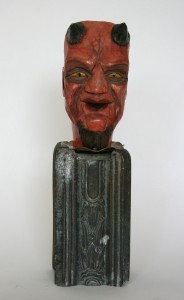Mr. Scatter hasn’t been writing a lot lately, at least not for print. Lots of notes, lots of transcriptions, lots of interviews and looking at stuff and thinking about it, but not so much for instant gratification — Mr. Scatter’s or his readers’.
 In case you missed it, he did have this piece in last Friday’s A&E section of The Oregonian, a reflection on that not-so-polite (and extremely loosely organized) form of art known variously as folk, outsider, naive, primitive, self-taught, you name it.
In case you missed it, he did have this piece in last Friday’s A&E section of The Oregonian, a reflection on that not-so-polite (and extremely loosely organized) form of art known variously as folk, outsider, naive, primitive, self-taught, you name it.
A recent trip to the Bay Area has got him to thinking about artists like The Hairy Who (from Chicago, but they had a big influence on the Bay Area Figurative Art scene) and Robert Arneson, and of course the splendidly loony master cartoonist R. Crumb, whose surprising take on the Book of Genesis is at the Portland Art Museum right now, and fun and funk, and the disappearing distance between high and low art, “taught” and “outsider” art. That’s what the A&E piece is about, in the context of Portland’s variously beloved and maligned Alberta Arts District scene. ‘Nuff said. Read it for yourself.
 While he was in Baghdad by the Bay, Mr. Scatter stayed in Japantown, where the view out his window was the pagoda at right. Best thing about the very good hotel where he stayed, thanks to an excellent online deal: the long deep Japanese soaking tub, which he filled with hot water nightly to wash away the stress of those up-and-down hills. He tried not to think about the ungodly amount of water he was using. Sometimes, a person splurges.
While he was in Baghdad by the Bay, Mr. Scatter stayed in Japantown, where the view out his window was the pagoda at right. Best thing about the very good hotel where he stayed, thanks to an excellent online deal: the long deep Japanese soaking tub, which he filled with hot water nightly to wash away the stress of those up-and-down hills. He tried not to think about the ungodly amount of water he was using. Sometimes, a person splurges.
San Francisco is a great place to eat, maybe right up there in the United States with New Orleans and New York, and Mr. Scatter had a bite or two. About a third of the city’s population is Asian, and it follows that eating in Asian spots can be a good bet, even little ones that don’t get much press. That was the deal with a little Korean diner he found one night: good bubbling stew with soft tofu and little oysters. But the side dishes, or banchan, were knockout: nine little bowls of kimchi and other various fermented sprouts, cucumbers, radishes and the like, including a dish of dried anchovies that had been partially reconstituted with oil, giving them a sharp funky taste and a chewy, almost woody texture. Outstanding. San Francisco treat or not, Rice-A-Roni didn’t stand a chance.
*
ILLUSTRATIONS, from top:
— Tabor Porter, carved devil figure, courtesy Guardino Gallery.
— The view from Mr. Scatter’s window: the pagoda in San Francisco’s Japantown. Wikimedia Commons.

